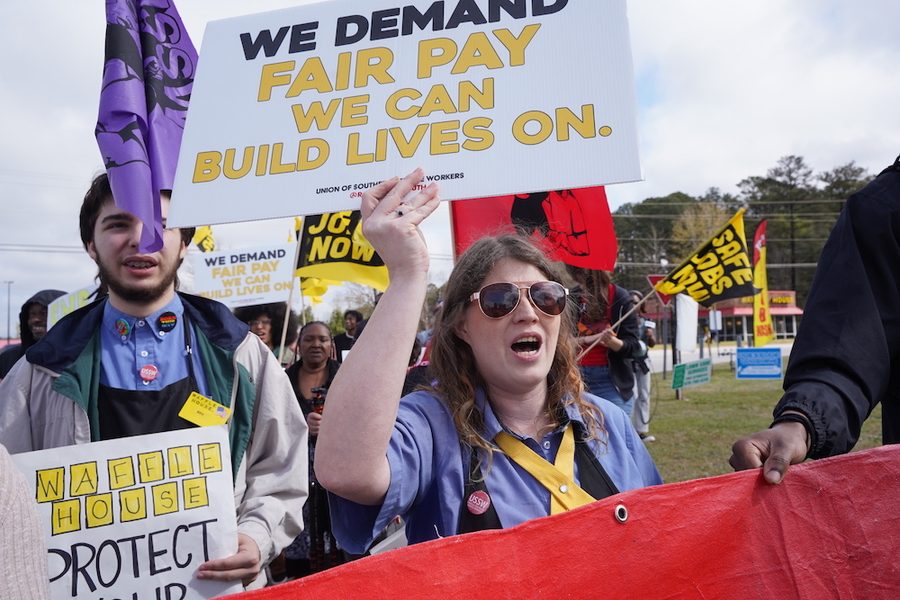
Disaster preparedness is as much a part of the Waffle House brand as its all-day breakfast offerings. The 24-hour diner chain — home of a utilitarian menu of generously smothered, covered, scattered and peppered hash browns, among other quick-serve favorites — is omnipresent throughout the Midwest and Southeast. Its iconic butter-yellow letters have welcomed many a weary traveler since its founding in 1955, and its reputation for reliability is far more than a marketing tactic. In 2011, Federal Emergency Management Agency (FEMA) administrator Craig Fugate created the “Waffle House Index” — a metric for measuring the severity of an oncoming storm. “If you get there and the Waffle House is closed?” Fugate has said. “That’s really bad. That’s where you go to work.”
Jamal Gleaton, 25, practically grew up at Waffle House. He remembers tagging along as his mother clocked in for her 7a.m. shifts at a location in Cayce, S.C.. He’d kill time before school by chatting with her regulars, who in turn kept an eye on him and his siblings. Now Gleaton works at the same Waffle House where he spent all those frantic mornings as a kid. His mother is still there, too, slinging the same hash browns and pouring the same strong black coffee.
Earlier this month, anxieties across the Southeast flared as Hurricane Helene gathered strength just off the coast. State officials were aware that South Carolina was in its path and made preparations, while many residents evacuated. But the intensity of the storm still came as a surprise, leaving swaths of the state without electricity, water or power.
Gleaton’s mother, however, went to work as usual that morning.
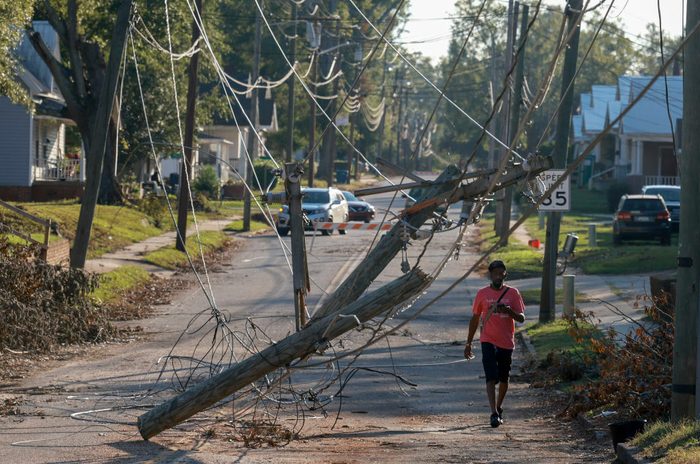
The power was already out, so she and her coworkers worked by candlelight for as long as they could, serving a limited menu and doing what they could to help the frightened people who streamed through the door. After they left, the store manager and a relief manager who’d come in to assist during the storm kept the location running themselves. “They did maybe 1,800 [customers] with no power, just candlelight,” Gleaton says. “When I came in for the second shift at 2p.m., when I walked through the door, it was like God said, ‘Let there be light,’ and the lights came back on!”
Even with power restored, he says, the situation remained “nerve-wracking.” Customers who had just lost everything — or were afraid that they still might — took out their emotions on the workers and complained about the limited menu. Nevertheless, for days afterwards, they kept on coming. There were precious few alternatives, as most other restaurants and stores remained closed. As the only server (“salesperson” in Waffle House parlance) working the floor, Gleaton could barely keep his own head above water.
“Every day, I did 2,000 plus,” he says. “I was exhausted. Everybody stared at me, like I was just supposed to make things better, and I didn’t know what to do. I’m not the savior. I’m not the Messiah. I know why y’all here. Y’all know why I’m here. I’m trying to accommodate everybody, but at one point it just was too much.”
The hectic situation at Gleaton’s store has calmed down, but Helene’s aftermath continued to impact his community and his customers. For days, locals whose homes (and kitchens) were damaged by the storm still come to his Waffle House for meals, to charge their phones, to fill up on water, to grab to-go cups of milk for their kids, or just to sit somewhere brightly lit and friendly for a couple of hours.
Gleaton was happy he could provide that for them, but admits it is frustrating for workers like him to see the lack of respect and acknowledgement that he and other service workers receive from their employers and the public writ large, even after stepping up during a literal disaster.
“We were really providing so much for the community, and people do not think about that,” he tells me. “They belittle it, they downplay it, as if it’s not a lifesaver, and it literally was.”
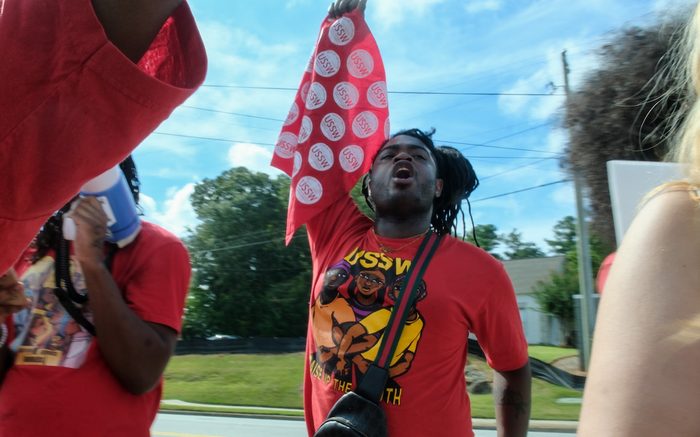
Gleaton has been working at Waffle House on and off since 2019, and is still making less than five dollars an hour before tips. Those can range widely, from $60 to $180 per shift. “There are people who have been with the company for years, I’m talking 20 plus, and they do not make what I make,” he tells In These Times. “We’re talking diamond service, over a million people served, and they’re still making maybe a little over $3.”
It used to be even less. In May 2024, Waffle House CEO Joe Rogers III announced that the company would be making its “single largest additional investment in our workforce” by raising the base pay for servers like Gleaton to three dollars an hour.
That raise came as a direct result of a yearlong campaign led by the Union of Southern Service Workers (USSW), a worker-led union of low-wage service workers backed by the Service Employees International Union’s long-running Fight for a Union campaign (formerly Fight for $15 and a Union). The USSW has continued to push for more, calling for a $25 hourly wage for its members. “25 is a number,” Gleaton explains. “What we’re actually fighting for is a livable wage, because the cost of living just keeps skyrocketing. The whole inflation thing, it’s not getting no better for us, and they’re making it even harder, taking our credit card tips and then taxing them.”
USSW members like Gleaton are also pressing Waffle House to end its meal deduction policy (in which workers can only order off a limited menu and are charged whether or not they partake), and, even more importantly, to provide 24/7 security at its restaurants (workers say security is currently inconsistent). It’s no secret that the 24-hour diner can get a little rowdy, especially on weekend nights, when customers often show up drunk.. “I’ve probably cleaned blood off of every surface of a Waffle House,” Halie Booth, a Texas Waffle House worker whose gifted reflexes turned her into a meme queen, told the Independent (UK) in 2023.
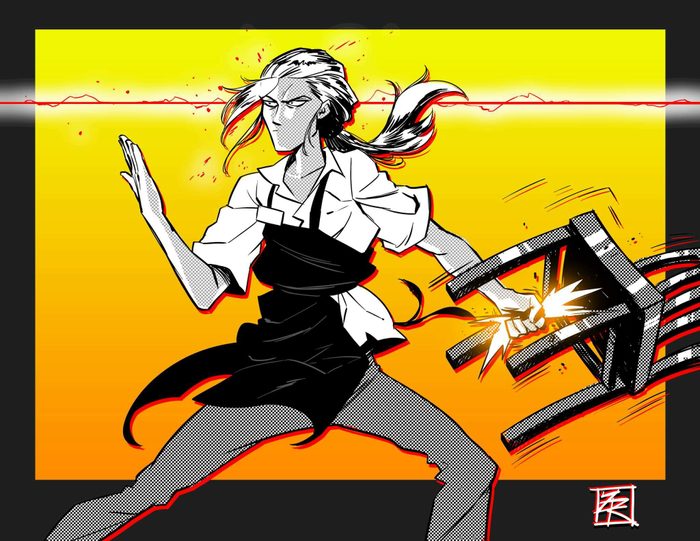
Endless “Waffle House Fight” memes and hours of video footage of carb-fueled brawls make light of the matter, but for the people who actually work there, though, there’s nothing funny about the prospect of having to handle drunk, disorderly or violent customers with no backup. “It’s not necessarily that you have to know how to fight, but you have to be tough,” Gleaton sighs. “Waffle House is not for the weak at all. They will eat you up and spit you out if you let them. … People and alcohol don’t mix. They come in belligerent, they come in irate, they come in just being disrespectful, and they feel like it’s owed to them. We’re supposed to just take it, and it’s unacceptable.”
On September 29, a BioLab chemical plant in Conyers, Ga., caught fire and shot a massive plume of chlorine-laden smoke into the air over the area. 17,000 people and local businesses were encouraged to evacuate; those who stayed behind were told to stay inside, with their windows closed and air conditioners off, to avoid the contaminated air. The warning was not lifted until 8 p.m. that evening. By then, Katie Giede had already been at work for hours, serving customers at a Waffle House six miles away from the BioLab plant.
She didn’t feel she had much of a choice. “If you don’t show up for those shifts, you can actually get in trouble or get fired because they’re considered emergency situations,” she explains. “Your job kind of depends on it; you have to be in there, and then once you’ve done it, there is no recognition.” Giede has chronic bronchitis, and had already noticed smoke and a distinct odor in the air when she left her house earlier that day. She wore a mask to protect herself, but it could only do so much. After the news broke, her location on Flat Shoals Road stayed open but moved to a limited, takeout-only menu. Cranky customers who saw that the restaurant was open and assumed that meant everything was normal took out their disappointment on her and her coworkers.
“The customers are angry they’re not getting what they want,” she explains. “When it’s an extreme situation like that, everybody’s nerves are on edge, the customers blame the servers, and we end up making less because of it. I had to leave early on Tuesday because it had got so bad I could barely take any orders, I couldn’t breathe, and from the time I’d got there at 6:30 a.m. that morning until 12:30 p.m., I made $12 [in tips].”
Days after that shift, Giede was still struggling with her breathing. After six hours of work and at a base wage of $3 an hour, she had taken home a grand total of $30 — before tax.
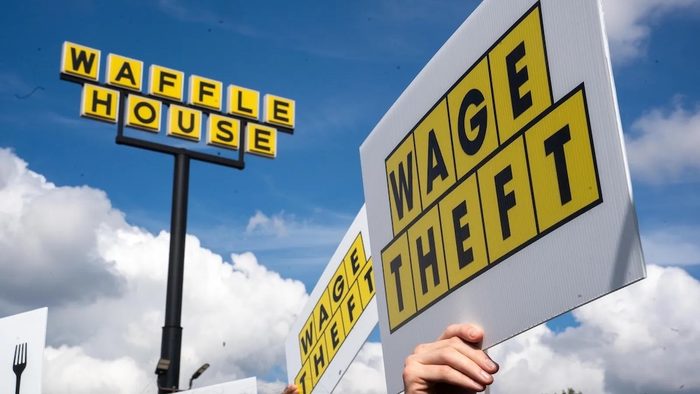
She’s been working at Waffle House on and off for the past decade, and experiences like that have only hardened her resolve to bring about change. This wasn’t even her first disaster. Years ago, when she was still new to the company, a tornado swept through her neighborhood. As she stared out the restaurant window at the dark sky, debris flew by. No customers were coming in, but she was told she had to stay in the building. “I arrived home that morning and there was a tree through half of my house,” she recalls. She was working the second and third shifts at the time, so there was little time to deal with it. “I would have had to be back at work at two o’clock that afternoon.”
That memory must have been at the top of her mind when a coworker told her about the USSW last year; she eagerly jumped right in. “These corporations don’t realize what us on the bottom are going through,” she says. ‘I’m a single mom, and my nieces are coming into the workforce, and I don’t want them to have to deal with this same kind of stuff that we’re dealing with as women, as minorities, as just humans in general. We need to be treated better, and it’s time that it happened.”
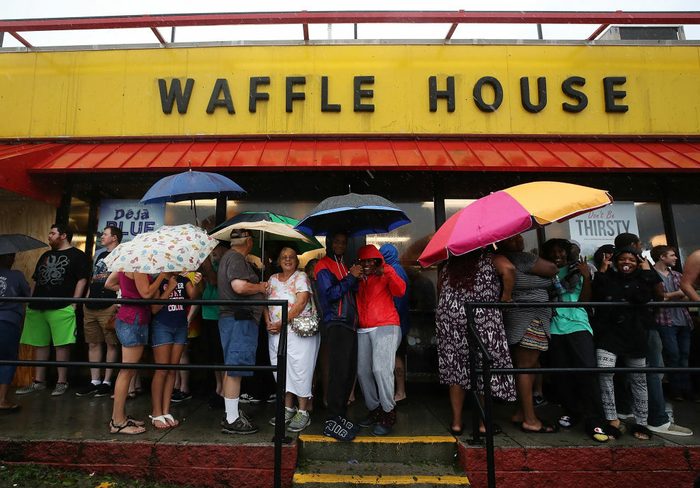
As the climate crisis intensifies and extreme weather events become even more frequent, Waffle House workers like Jamal Gleaton and Katie Giede will continue to be thrust out onto the front lines of disaster after disaster. Waffle House is many things — a roadside institution, a dependable purveyor of waffles, FEMA’s favorite restaurant, a comforting sight after a long road trip, a deeply American inside joke — but above all, it is a $4 billion company that can absolutely afford to properly compensate the people who make all those damn waffles in even the most extreme conditions.
“People treat it like it’s a joke, ‘Oh, if Waffle House is closed, you should be scared,’ but these are real people with real lives and real families that they’re forcing to still be inside these businesses, just so they can try to make a profit out of these situations,” Giede emphasizes. She hopes that she and her fellow USSW members will continue to be able to push the company in the right direction — and to win the respect they so deeply deserve.
“It’s not a joke to us,” she says. “It might be funny to you, but we’re literally out here fighting for our lives and for our families.”
Kim Kelly is a freelance journalist and author based in Philadelphia, PA. She is a labor writer for In These Times, a labor columnist at Teen Vogue and Fast Company, and regularly contributes to many other publications. Her first book, FIGHT LIKE HELL: The Untold History of American Labor, is now available from One Signal/Simon & Schuster. Follow her on Twitter at @grimkim and subscribe to her newsletter, Salvo, here.








